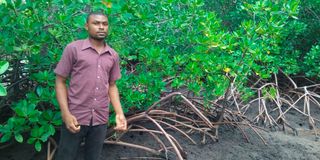Premium
UN honours Kenya’s Mikoko Pamoja Mangrove conservation

The project Mikoko Pamoja, is the first community-owned initiative of its kind in the world to use sale of carbon credits to fund mangrove conservation alongside community development.
Project manager Josphat Mwamba, explaining how the project started and its impact on the world.
What you need to know:
- Mangroves protectors recognised because of the vital role they serve as habitat for various marine species and coastal communities
- Today, “The Gazi community has demonstrated how local action can have a global impact, by maintaining the delicate balance between human needs and environmental protection.”
The United Nations has named Mikoko Pamoja Person of the Year, recognising the Gazi community’s progress in conserving the mangrove ecosystem and pioneering global carbon financing.
For years, the Gazi Bay community in Kwale County had relied on mangrove forests for timber, threatening the very ecosystem they depended on.
Recognising the unsustainability of this practice, they embarked on a journey in 2013, to restore and protect over 117 hectares of mangrove.
Speaking at the award ceremony, James Kairo, founder of Mikoko Pamoja and Project Developer and Chief Scientist at Kenya Marine and Fisheries Research Institute, said mangroves were vital to coastal communities, serve as habitat for marine species, protect against storm surges and play a crucial role in carbon sequestration.
He stressed that the degradation of these mangroves has far-reaching consequences, affecting both marine life and the environment.
“Mangroves are not just trees; they are the guardians of our coasts, keepers of our marine treasures and sentinels of a stable climate. Protecting them is not an option; it is imperative for the well-being of coastal communities and future of our planet,” he said.
Carbon credit sales
Mikoko Pamoja, which means ‘Mangroves Together’, is more than an environmental initiative; it is a community empowerment movement. Its innovative approach to mangrove conservation has created a unique revenue stream through the sale of carbon credits, which directly benefits community development.
“Since its inception, Mikoko Pamoja has generated $210,000 (Sh32 million) for the community and avoided 18,500 tonnes of carbon dioxide emissions. This funding has enabled the installation of piped water systems, improved educational facilities and improved health services.
Proceeds from the sale of carbon offsets have enabled the construction of schools, hospitals and access to clean water for more than 7,000 people in the villages of Gazi and Makongeni,” he said.
According to the United Nations Environment Programme (Unep), mangroves play a critical role in climate protection, acting as carbon-rich fortresses that store significant amounts of carbon.
When these ecosystems are degraded or converted to other uses, they not only stop sequestering carbon, but also release stored carbon into the atmosphere, contributing to global warming.
Mr Kassim Juma, Mikoko Pamoja's project coordinator, emphasised the project's dual commitment to environmental protection and community empowerment.
“The essence of Mikoko Pamoja lies in its ethos of combining environmental stewardship with community empowerment. By restoring our mangroves, we are protecting our coastline and creating an empowered future for our people,” said Mr Juma.
Mr Stephen Jackson, United Nations Resident Coordinator, said the community celebrates this prestigious recognition and that Mikoko Pamoja will be a shining example of how to drive positive change for the environment and their own empowerment.
“Today, the Gazi community stands as a beacon of hope, demonstrating how local action can have a global impact. Their efforts underscore the delicate balance between human needs and environmental protection, and highlight the power of community engagement and innovation,” he said.





